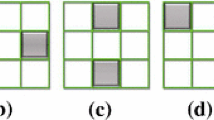Abstract
For the conversion of a color image to a perceptually plausible grayscale one, the global and local contrast are simultaneously considered in this paper. The contrast is measured in terms of gradient field, and the energy function is designed to have less value when the gradient field of the grayscale image is closer to that of original color image (called target gradient field). For encoding both of local and global contrast into the energy function, the target gradient field is constructed from two kinds of edges : one that connects each pixel to neighboring pixels and the other that connects each pixel to predetermined landmark pixels. Although we can have exact solution to the energy minimization in the least squares sense, we also present a fast implementation for the conversion of large image, by approximating the energy function. The problem is then reduced to reconstructing a grayscale image from the modified gradient field over the standard 4-neighborhood system, and this can be easily solved by the fast 2D Poisson solver. In the experiments, the proposed method is tested on various images and shown to give perceptually more plausible results than the existing methods.
Access this chapter
Tax calculation will be finalised at checkout
Purchases are for personal use only
Preview
Unable to display preview. Download preview PDF.
Similar content being viewed by others
References
Agrawal, A., Raskar, R.: What is the range of surface reconstructions from a gradient field. In: Leonardis, A., Bischof, H., Pinz, A. (eds.) ECCV 2006. LNCS, vol. 3951, pp. 578–591. Springer, Heidelberg (2006)
Čadík, M.: Perceptual evaluation of color-to-grayscale image conversions. Pacific Graphics 27, 1745–1754 (2008)
Davis, T.A.: Direct Methods for Sparse Linear Systems. SIAM, Philadelphia (2006)
Gooch, A.A., Olsen, S.C., Tumblin, J., Gooch, B.: Color2gray: salience-preserving color removal. In: SIGGRAPH, vol. 24, pp. 634–639 (2005)
Heckbert, P.: Color image quantization for frame buffer display. Computer Graphics 16, 297–307 (1982)
Kaleigh, S., Pierre-Edouard, L., Joëlle, T., Karol, M.: Apparent greyscale: A simple and fast conversion to perceptually accurate images and video. In: Eurographics, vol. 27 (2008)
Kim, Y., Jang, C., Demouth, J., Lee, S.: Robust color-to-gray via nonlinear global mapping. In: SIGGRAPH ASIA, vol. 28 (2009)
Mark, G., Dodgson, N.A.: Fast, contrast enhancing, color to grayscale conversion. Pattern Recogn. 40, 2891–2896 (2007)
Nayatani, Y.: Simple estimation methods for the helmholtz-kohlrausch effect. Color Res. Appl. 22, 385–401 (1997)
Neumann, L., Čadík, M., Nemcsics, A.: An efficient perception-based adaptive color to gray transformation. In: Computational Aesthetics in Graphics, Visualization, and Imaging, pp. 73–80 (2007)
Press, W., Teukolsky, S., Vetterling, W., Flannery, B.: Numerical Recipes in C. Cambridge University Press, Cambridge (1992)
Rasche, K., Geist, R., Westall, J.: Re-coloring images for gamuts of lower dimension. In: Eurographics, vol. 24, pp. 423–432 (2005)
Rama, A.A., Agrawal, A.: An algebraic approach to surface reconstruction from gradient fields. In: ICCV, pp. 174–181 (2005)
Saad, Y.: Iterative Methods for Sparse Linear Systems. SIAM, Philadelphia (2003)
Author information
Authors and Affiliations
Editor information
Editors and Affiliations
Rights and permissions
Copyright information
© 2011 Springer-Verlag Berlin Heidelberg
About this paper
Cite this paper
Kuk, J.G., Ahn, J.H., Cho, N.I. (2011). A Color to Grayscale Conversion Considering Local and Global Contrast. In: Kimmel, R., Klette, R., Sugimoto, A. (eds) Computer Vision – ACCV 2010. ACCV 2010. Lecture Notes in Computer Science, vol 6495. Springer, Berlin, Heidelberg. https://doi.org/10.1007/978-3-642-19282-1_41
Download citation
DOI: https://doi.org/10.1007/978-3-642-19282-1_41
Publisher Name: Springer, Berlin, Heidelberg
Print ISBN: 978-3-642-19281-4
Online ISBN: 978-3-642-19282-1
eBook Packages: Computer ScienceComputer Science (R0)




